This is part two of my interview with Ron Nehrig. In part one, we learned about growing wheat and other grains. If you missed the first part of the interview, go here to read it first. This is truly a local farm-to-table story and you don’t want to miss anything.

Sunflower Patch
Photo by Ron Nehrig on Flickr https://www.flickr.com/photos/ronnehrig/sets
Interview with Ron Nehrig -Part 2: Milling Grains for Bread
Part two focuses on some of Ron’s other interests, such as his expansive garden and how he got started baking bread. He also shares some of the tools he uses for milling grains at home for bread.
What else do you grow besides wheat?
I grow a pretty large garden; usually 36 tomato plants, 36 peppers, a number of varieties of each of those, broccoli, cabbage, cucumbers, corn for eating and for milling. I have grown many more garden vegetables in the past, but have trimmed it down to what are the most important to me now. I also grow large plots for the birds, turkeys, deer, bees and other critters; wildflowers, sunflowers, Medium Red Clover or Buckwheat when I’m resting a plot, and various grains, such as sorghum or Egyptian Wheat (actually a sorghum).
I’ve grown sugar sorghum and made sorghum molasses, and a few years ago I grew a fairly large plot of Brown and Yellow Mustard and harvested the seed, much like harvesting grain, which I’m still using to make mustard, which is the best mustard my friends and I have ever tasted, and also makes fantastic mustard/pickle relish using my canned pickles—it can be pretty spicy.
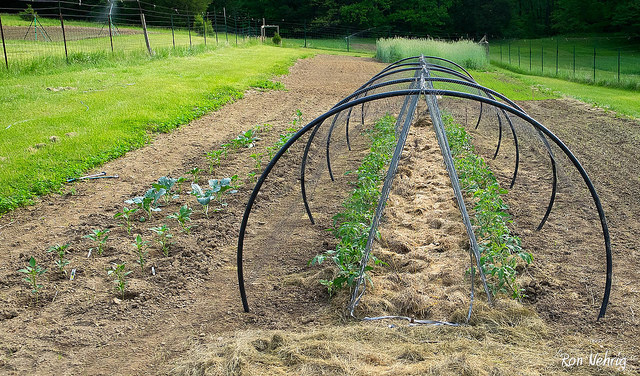
Garden
Photo by Ron Nehrig on Flickr https://www.flickr.com/photos/ronnehrig/sets
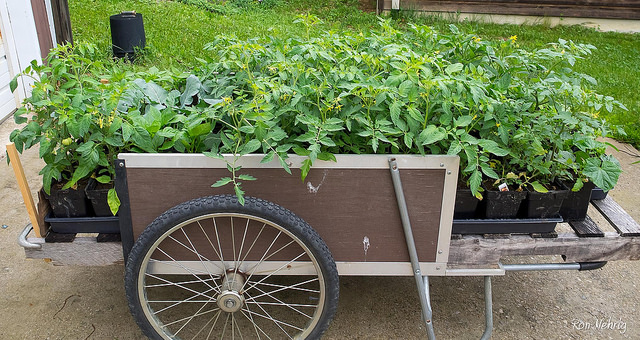
Getting ready to plant
Photo by Ron Nehrig on Flickr https://www.flickr.com/photos/ronnehrig/sets

Enjoying sweet sunflower seeds
Photo by Ron Nehrig on Flickr https://www.flickr.com/photos/ronnehrig/sets
Do you do any canning?
I can tomato sauce, cooked down, which I use in sauces for pasta, pizza, or whatever. I also can pepper sauce, which is a mix of Anaheim, Jalapeno, Fooled You, and Cherry Peppers, together with cider vinegar, cooked down, blended until smooth (like ketchup), and used in many things, including pizza sauce, salsa, soups, beans and bean dip, tacos and other dishes; this isn’t a commercially available product, and it is so useful. I also make sweet pickles, but not too sweet, which I often use together with my mustard for amazing mustard/pickle relish, or in Thousand Island dressing for Reuben sandwiches. I used to do a lot more canning; whole tomatoes, green beans and things like that, but now usually just cook large batches of salsa, chili, and spaghetti sauce when the garden is doing well, and freeze them in dinner size containers, along with sweet corn, peppers and other things.
How long have you been baking bread and how did you get started?
My mother made bread when we were younger, but she stopped at some point. I started making bread when I was twenty-two or so, for the same reason that I grew gardens and cooked…to make bread that was better than I could buy. I started with bread recipes from books, from the Kitchen Aid recipe book, Bernard Clayton’s early books, and have read many of the popular recent bread books. In most I’m struck by how few popular author/bakers have tried milling their own flour, and how little they know about it, and a great many household bakers follow their lead, and they’re missing out on so much.
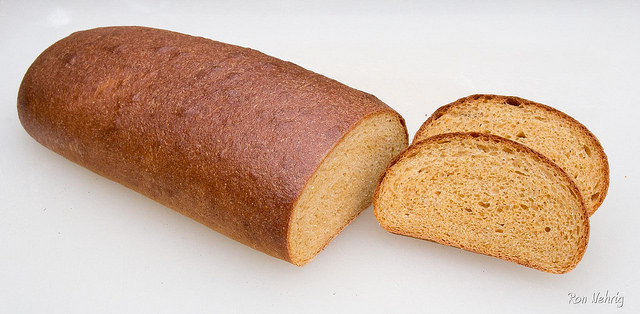
Daktyla, Greek Village Bread
Photo by Ron Nehrig on Flickr https://www.flickr.com/photos/ronnehrig/sets
Do you use any special equipment when making bread?
My kitchen equipment includes a 4.5 qt Kitchen Aid Ultra Power mixer that I have used for 3 lb dough batches (two loaves) for over twenty years, a 7 qt Kitchen Aid ProLine that I use for 6 lb batches (four loaves) so I can freeze bread when I’m busy doing other things, a WonderMill grain mill that makes milling small amounts of grain a pleasure instead of a chore, a large baking stone for the oven, a 10” fine flour sifter that I use to sift out the bran flakes that sneak through the first milling so I can re-mill them into finer particles and add them back to the flour for smoother dough and finer cell walls, and the usual pile of pans and sheets for baking a variety of breads.
Do you have a favorite bread you like to make with your home-grown and home-milled wheat?
Many of my recipes for bread and other foods are on my blog at: http://ronnehrig.blogspot.com/
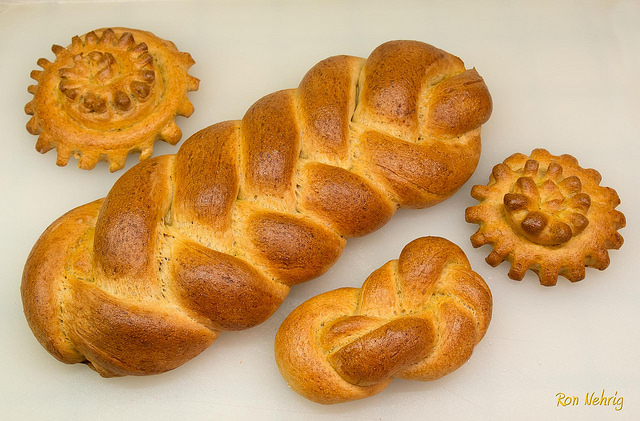
Challah
Photo by Ron Nehrig on Flickr https://www.flickr.com/photos/ronnehrig/sets
I say “many recipes” because I seldom make the same bread twice. I have 10 or 12 grains in my cupboard, and like to vary the mix of grains each time, to learn something, and just to have something different; this is not possible without milling my own grain, because keeping all of these grains as flour guarantees that they are old, which I do not consider to be acceptable for good bread. I build each recipe in a spreadsheet which probably has hundreds in it by now. I have included some of my favorite recipes on the blog, but they are only templates, which I play with each time I bake bread. Corn bread starts with a basic recipe, but then will have a varying mix of my corn varieties, it might have Hard White Spring Wheat, Hard Red Winter Wheat, even Soft Red winter wheat, or Khorasan, in varying percentages.
My sandwich bread often has as many as seven grains, such as White Wheat, Red Wheat, Khorasan, Oats, Rye, Corn, all in the same bread, and different almost every time, just for fun, though I sometimes repeat recipes that I really like.
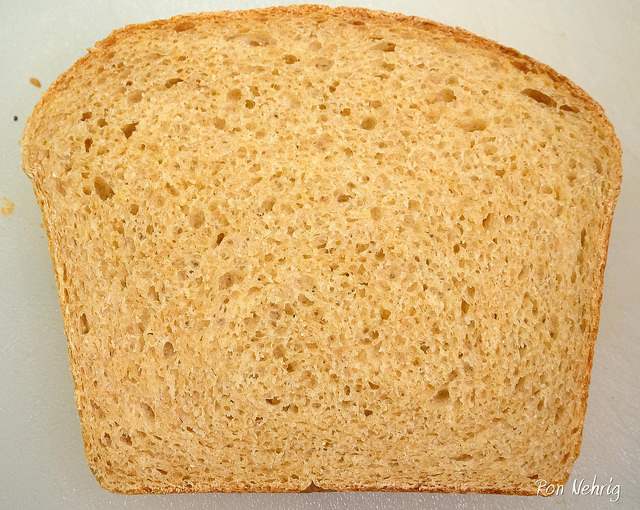
Crumb Shot of Sandwich Bread
Photo by Ron Nehrig on Flickr https://www.flickr.com/photos/ronnehrig/sets
I frequently use Sourdough, which I made myself with fresh milled Hard White Spring Wheat, and sometimes I feed it a little Rye to keep it happy; in my house the sourdough became mild and flavorful, not too sour, but enough to be noticeable without jumping out. I don’t like flavors that jump out; I like flavors that play well with each other and contribute to a complex taste without over-powering it.
Is there anything else you would like to share with your fellow bread bakers?
If you don’t mill your own flour you’re missing out on a chance to experiment with the many grains that are only available as unmilled grain, and missing out on the flavors and aromas that grains were born with, because most of those flavors don’t age well. I now consider flour to be as perishable as any garden vegetable–it is best when it is fresh; once it’s milled it starts to oxidize, lose its aroma and flavor to the air, absorb flavors and aromas from the air that I don’t want in my bread, and generally goes downhill, with us usually none the wiser, because we don’t know any better. A good grain mill opens an entirely new world of baking using a variety of fresh grains that are not possible without milling, and I always enjoy the sweet aromas of fresh milled grains, something bags of flour just don’t have.
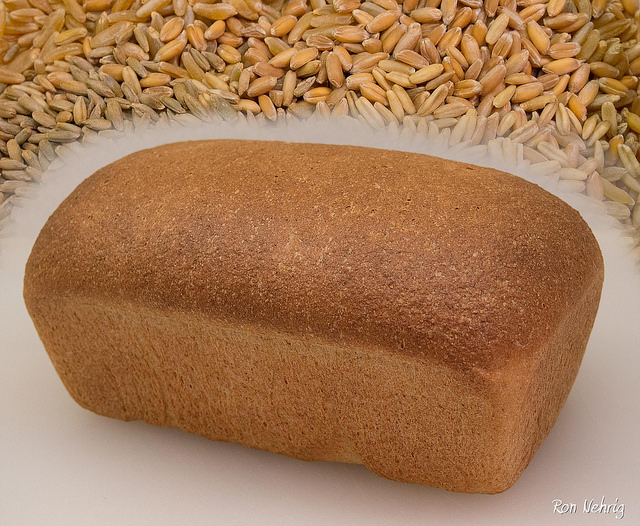
Grain to Bread, the Staff of Life
Khorasan Wheat, Spelt Wheat, Oats, Rye, and Hard White Spring Wheat.
Photo by Ron Nehrig on Flickr https://www.flickr.com/photos/ronnehrig/sets
My suggestion is to give milling a try, do some exploring; put aside your bread books and make something new and exciting; but get a good mill that is easy to use so it isn’t an obstacle to having fun in the kitchen. My own suggestions are the WonderMill or Nutrimill; I haven’t used a Nutrimill, but it uses the same technology as the WonderMill, and I’ve researched it quite a bit. When I bought mine I thought WonderMill was the best choice; Nutrimill has since added some new features that may or may not be useful, so the choice may be more difficult now, but I’m very happy with the WonderMill and it has milled a lot of grain.
My process is that I weigh out a bunch of different grains for my current batch of bread into separate plastic containers, then dump them in the mill (adding the corn last because it is the biggest and I will adjust the feed dial to compensate), and in a few minutes (literally) I have enough flour for two or four loaves of bread; no dust on the counter, no mess. I have friends that have other mills, with stones or steel burrs, and they seem to buy a lot of bread because milling is time consuming and messy. I have used a number of other mills as well, and did not find them pleasant. So my suggestion is don’t start out with something cheaper, thinking you’ll work your way up—you may just find it isn’t worth the time and give up on milling.
And last, even if you can’t grow a large plot of Wheat or Rye you may have room to plant a tiny plot, just for the experience of watching it grow, and harvesting it by hand, like humans have done for thousands of years.
I want to thank Ron for sharing his passion for growing and milling grains and providing a glimpse into what living off the land really means. I’m ready to try my hand at growing a little wheat. How about you?
Read Part One of my interview with Ron to learn about growing wheat and other grains.
Visit Ron’s Blog at http://ronnehrig.blogspot.com/ for more information and to try some of his bread recipes.
To view more of his gorgeous photos, visit him on Flicker https://www.flickr.com/photos/ronnehrig/sets/72157644915028047
Tillie says
THANKS I would like the recipe for making bread from grains only for my own use I been trying to get a recipe from all over its heavy and not risen properly the ones I tried and I would not like to waste more of my time and flour to make another loaf thanks Tillie please get back to me
Cathy says
Tillie, I’m not sure which recipes you are referring to but if you’re looking for Ron’s recipes, there is a link to his blog on this page. You can check out some of his recipes there. Keep in mind it takes practice to learn how to work with whole grains especially home-milled. Breads made with home-milled grains typically require more liquid and don’t rise as high as breads made with white flour.